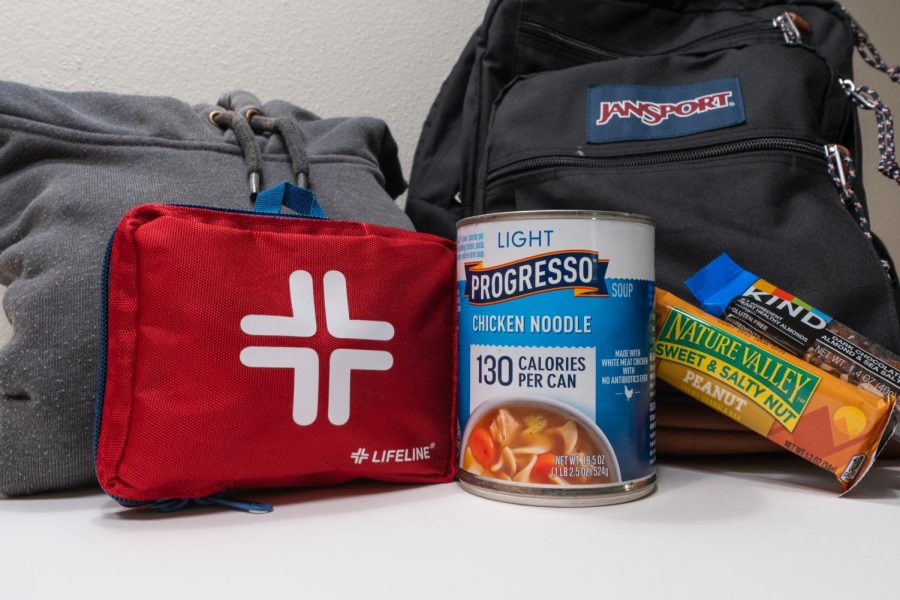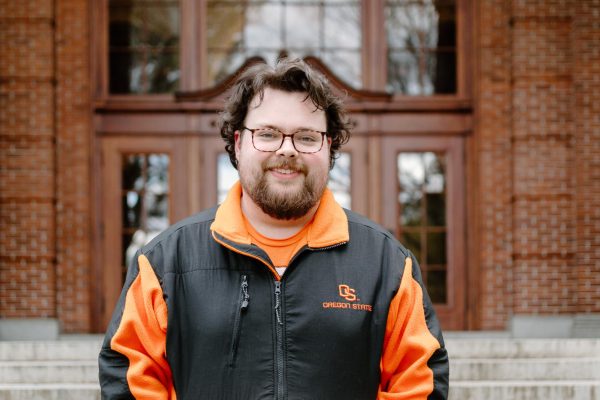‘Earthquakes can happen anytime, anywhere:’ What can OSU do to prepare?
A photo illustration depicting supplies and food for an earthquake taken on Feb. 19. Preparation for an earthquake is important for limiting injuries as well as reducing the chances of hazardous situations.
March 6, 2023
While an earthquake would shake up life on campus and in Corvallis, OSU experts said the risks posed to both people and structures can be mitigated with effective preparations.
The Danger
According to Andrew Meigs, a professor of geology in OSU’s College of Earth, Oceanic and Atmospheric Sciences, two faults, the Cascadia Subduction Zone and the Corvallis Fault, are potential earthquake risks for Corvallis.
The Cascadia Subduction Zone and Corvallis Fault are capable of producing a magnitude 9 and magnitude 7 earthquake, respectively.
The odds of an earthquake occurring in the next 50 years along the Cascadia Subduction Zone between Vancouver Island and southern Oregon is between 10% and 17%, Meigs said.
It’s been 323 years since the last earthquake along the fault, where earthquakes occur on average once every 500 to 600 years, although Meigs noted the time between earthquakes on the fault has been as short as 150 years and as long as 1,000 years.
“The one thing that you can say is that it is an inevitability,” Meigs said. “That earthquake will occur; when it will occur is anyone’s guess right now.”
The risk posed by the Corvallis Fault, meanwhile, is far harder to predict, since there is no consensus as to whether or not the fault is active.
“We have almost no information at all about its activity in the last tens of thousands of years, which is the normal window on which we would like to have information about past earthquakes,” Meigs said.
The Damage
The risks earthquakes can pose was tragically illustrated on Feb. 6, when a magnitude 7.8 earthquake struck Turkey and Syria, with over 45,000 people killed, according to an AP report.
While buildings built to Oregon’s building code are safer in the event of an earthquake than those in Turkey, according to OSU Emergency Preparedness Manager Mike Bamberger, this doesn’t mean they wouldn’t suffer damage that could render them unusable.
Erica Fischer, an assistant professor of civil and construction engineering in OSU’s College of Engineering, describes modern buildings as being designed to handle earthquakes the same way cars are designed to handle crashes; the building suffers damage in an earthquake, but dissipates energy in order to protect those inside.
“We design buildings to be damaged in a systematic fashion such that the damaged portions of the building can be replaced and we can maintain life safety,” Fischer said. “This means that the building may not collapse, but it could be heavily damaged and the goal is to limit or prevent loss of life.”
While new buildings constructed in Oregon have to be designed with seismic concerns in mind, this hasn’t always been the case.
“Oregon was considered to have low seismic risk for a long time in our building code history,” Fischer said. “It is really only in the last 30 years that we have considered that most of Western Oregon has moderate to high seismicity.”
For older, more seismically vulnerable buildings, there are ways to retrofit them with seismic protections. According to Fischer, this can range from reinforcing old concrete and masonry structures — which can fail suddenly in an earthquake — to ensuring floors and walls are securely fastened together.
According to Bamberger, OSU Capital Planning and Development maintains a list of buildings identified as needing seismic renovation as part of their ten-year financial forecast.
OSU’s 2022-2032 forecast, available through the University Facilities, Infrastructure and Operations website, lists Gilkey Hall, Milam Hall, Kerr Administration Building and McAlexander Fieldhouse, as well as Hatfield Marine Science Center Building 900 in Newport, as slated for seismic renovations, while the CPD website also lists seismic improvements as part of the Cordley Hall Renewal Plan.
According to Bamberger, not every building is a suitable candidate for seismic renovation.
In the case of Weniger Hall, the cost of demolishing the building and replacing it with a new one was found to be more cost effective than retrofitting it to better withstand an earthquake. The current site of Weniger Hall will then be used for the to-be-constructed Collaborative Innovation Center, according to the CPD forecast.
Be Prepared
If you’re inside a building when an earthquake begins, according to Bamberger, the three things you need to do are drop, cover and hold on.
“We encourage people to get low to the ground or to the floor, so they don’t get thrown around, that’s the drop, get under something solid, that’s the cover…and then hold on, because you’re going to be violently (shaken),” Bamberger said.
One preparation that can be made for an earthquake is putting together a go bag, a kit containing enough essential supplies to last for 72 hours after a disaster.
According to Bramberger, priority items for a go bag would be a first aid kit, a supply of water and food and extra warm clothing such as a jacket.
Those living in a dorm or apartment may not have a lot of room to store supplies for an emergency, so Bamberger suggests finding multiple places to stash extra food and water, such as the back of closets or drawers. In particular, having access to clean water after an earthquake — or any other natural disaster — is important.
“It takes a gallon of water per person per day in a disaster, that’s the minimum you’ll need to cook, bathe, drink, clean cuts, all that kind of stuff,” Bamberger said.
In the aftermath of an earthquake, according to Bamberger, electricity and water service will take time to be restored, potentially up to two weeks. In the long term, classes would not resume for weeks afterwards, and would be virtual when they did.
Bamberger said those interested in learning more about emergency preparedness should visit the OSU Emergency Management website.
“Earthquakes can happen anytime, anywhere, so everybody has to invest in their preparedness, know what to do and have supplies to be able to survive afterwards,” Bamberger said.

























































































































